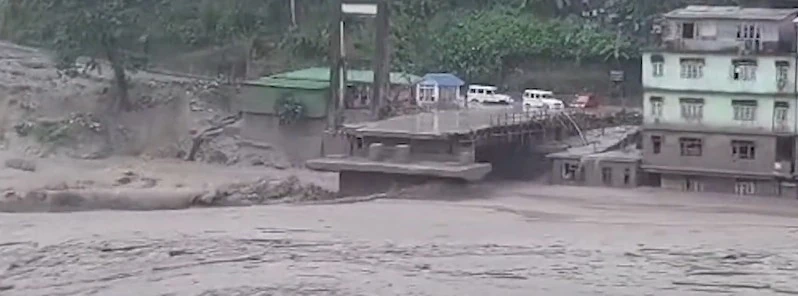Devastating flash flood in Sikkim’s Lachen Valley leads to widespread damage, 100 deaths and 76 missing, India

A glacial lake outburst flood (GLOF) triggered a rapid surge in water levels along the Teesta River basin in Sikkim, India at approximately 01:30 LT on Wednesday, October 4, 2023 (20:00 UTC, October 3). The water levels soared to heights of 5 – 6 m (15 – 20 feet), resulting in significant infrastructure damage, at least 100 fatalities, and 76 individuals reported missing.
Defense officials reported that establishments along the Lachen Valley have been adversely affected. While details are still being confirmed, it is clear that this event has had a broad impact on the region.
Lt. Col Mahendra Rawat, a defense spokesperson, stated that Army vehicles parked at Bardang near Singtam have been affected by the flash flood. He also reported that 23 Army personnel are missing and 41 vehicles are submerged under slush.
The disaster has wrought havoc on infrastructure. Roads and bridges were destroyed, and many establishments in Mangan, Gangtok, Pakyong, and Namchi districts were damaged. One of the more significant losses is a 120 m (395 feet) cable suspension bridge at Singtam, also known as the Indreni bridge, which was entirely washed away.
Parts of the Teesta Dam at Chungthang, the largest hydropower project in Sikkim, were also washed away by the swollen river waters. This destruction has far-reaching implications for the state’s energy infrastructure.
The flood also severely damaged sections of the National Highway (NH-10) in Melli, a border town between Sikkim and West Bengal.
In response to the escalating situation, residents in the low-lying areas of Chungthang town and Singtam district in North Sikkim have been evacuated.
With multiple sectors affected, from civilian lives to military installations and crucial infrastructure, the full scale of the catastrophe is still unfolding.
Updates
October 5
The cause of the flood was initially attributed to a cloudburst over Lhonak Lake in Sikkim, India, along with the release of water from the Chungthang dam. However, the disaster has since been identified as the result of a glacial lake outburst flood (GLOF).
Officials said the death toll increased to 8, while 69 others (including 22 army personnel) remain missing.
Satellite images released by the Hyderabad-based National Remote Sensing Centre (NRSC) showed that the area of south Lhonak Lake was reduced by over 100 ha (247 acres) compared to its size on September 17. The NRSC satellite imagery revealed that the lake covered approximately 162.7 ha (402 acres). Its area increased to 167.4 ha (413 acres) on September 28 but drastically reduced to 60.3 ha (149 acres). This suggests that the lake outburst caused the flash flood.
Some scientists are speculating whether the M6.2 earthquake that hit Nepal at 09:21 UTC on October 3 might have destabilized the already vulnerable lake.
Visuals from Army search operation site as Sikkim becomes the recent victim of Himalayan Tsunami pic.twitter.com/H0cx0aVwKI
— Weatherman Shubham (@shubhamtorres09) October 5, 2023
October 9
The death toll rose to 77 and the number of missing to 100.
Water levels along the Teesta River “returned to normal” four days after the floods hit, an official from Sikkim’s state disaster control room told AFP.
The office said more than 2 500 people stranded in the floods had been rescued. Another 3 000 people were still stranded in several relief camps in the state’s north with airlift rescues delayed by bad weather, the office said.
More than 1 200 houses were damaged.
Landslides expert Dr. Dave Petley said satellite analyses are now suggesting that the likely cause of the flood disaster was a landslide into South Lhonak.
Some perspectives on the #sikkimflood disaster:
— Max Van Wyk de Vries (@Max_VWDV) October 8, 2023
1. A landslide of waterlogged lateral moraine triggered the GLOF.
2. As at Chamoli, the landslide moved tens of m prior to collapse.
3. Anthropogenic activity influenced both the consequences and the triggering of this disaster.
1/8 pic.twitter.com/gqfTGjbraQ
(thread) 1. @ndtv analysis of day-old satellite images show a landslide, exposed shoreline and broken ice floes on Sikkim's South Lhonak Lake with water continuing to flow out more than 3 days since the lake breached its banks to trigger deadly floods downstream. 📸:@Maxar pic.twitter.com/BWRKvk1dRh
— Vishnu Som (@VishnuNDTV) October 7, 2023
October 16
As of October 15, 2023, devastating flash floods and Glacial Lake Outburst Floods (GLOF) have resulted in 100 fatalities in the states of Sikkim and West Bengal in northeastern India. The events have also left 76 people missing, 30 injured, and have displaced 2 321 individuals into 20 relief camps.
References:
1 3 dead, 23 Army men go missing as cloudburst triggers flash flood in Sikkim – The Tribune – October 4, 2023
2 Parts Of Teesta River Dam Washed Away After Cloudburst In Sikkim – NDTV – October 4, 2023
3 Nepal earthquake or cloudburst? Scientists exploring cause of Sikkim floods – The Hindustan Times – October 5, 2023
Featured image credit: NationalDefence (stillshot)

Commenting rules and guidelines
We value the thoughts and opinions of our readers and welcome healthy discussions on our website. In order to maintain a respectful and positive community, we ask that all commenters follow these rules.